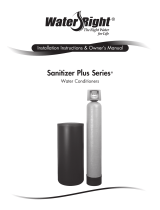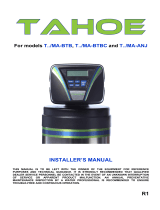
Fig.3.3.2 Flow Direction Sign
Fig.3.3.3 Connection of Inlet and Outlet Pipeline
Soft Water Outlet
Hard Water
Inlet
3/4” Female
Connection
By-Pass Valve
3.3 Inlet / Outlet Pipe Connection
Notice:
Note: The operation guide is for reference only. Please contact the tube and
pipe seller should there are questions.
Alert: If the household electric system needs the use of cooler system as
electrical safety grounding to earth, jumper is suggested to ensure that the entire
softenerpipe to ground.
3.3.1 Confirm that the inlet water valve is turn off and confirm the
water outlet location.
3.3.2 Connect the inlet pipe and outlet pipe to the by-pass valve
according to the arrows marked on the bypass valve for water flow
direction (Fig3.3.2). Inlet & outlet connection of the bypass valve is
a ¾” BSP male thread.
3.3.3 Connection of pipe and water softener should be done after
completion of all the welding of PPR or brass pipe (not included with
system) to avoid damage to the softener components by any heat
generated by welding.
PPR Pipe Installation
Step1: Pipe-cutting. Cut pipe with a pipe cutter.
Attention: Cut the pipe as flat as possible, or it will influence the
welding result.
Step2: Marking. Make marking on the pipe before welding.
Step3: Heating. Insert tube and fitting into the die at the same time.
Attention: The typical heating period time is 8-9 seconds. Insufficient
or overheating will cause under heating or pipe to collapse.
Step4: Welding. Remove the tubes and fittings out of the welder,
and insert in place quickly and smoothly without any rotation.
Attention: Should the connection time be too long, connection will
not be strong or not in place.
Step5: Cooling. It is important to cool the pipe after welding.
Attention: Cooling time is generally 4-5 seconds. Avoid twisting, bent
and pulled before sufficient cooling.
* Avoid knocking the pipes or tubing during storage, transportation
and installation process.
* UV protective measures and insulation measures should be
taken when mounting the pipes.
* Take into consideration that temperature may cause deformation of
the pipe for surface mounted and non-concealed type of pipe installation.
* During pipe installation, the working environment temperature is preferably 5 degrees Celsius
higher. If less than 5 degrees Celsius, the heating time required is extended by 50%.
* Do not over tighten thread connections. Over-tightening may cause damages to the threading.
* Place machine on a flat surface. Inlet and outlet pipes should be secured with pipe holder to
avoid additional pressure or weight exerted on the bypass valve.
* Insulate the pipes and valves should there be a possibility of freezing.
























